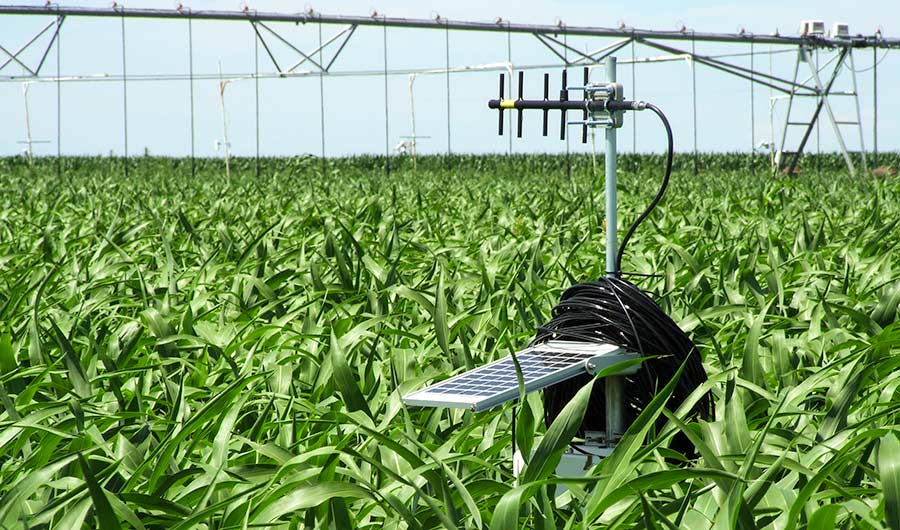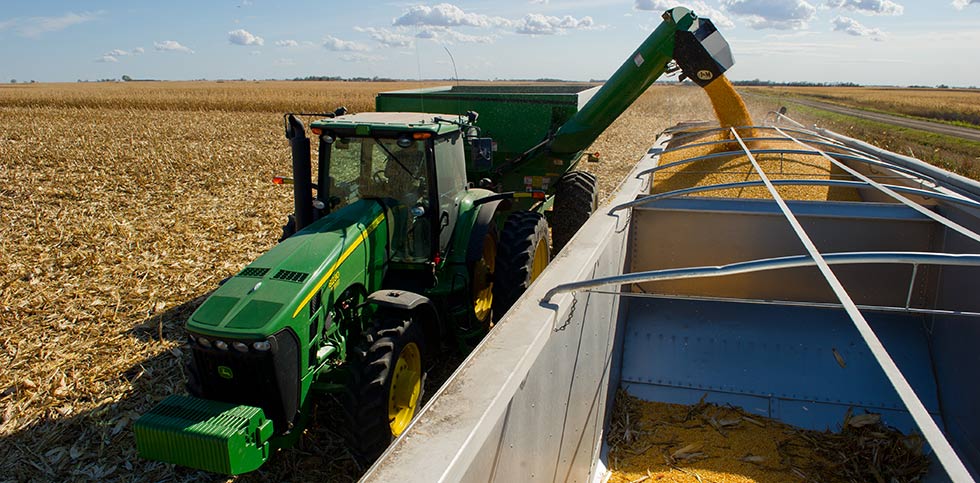How US Corn Farmers Adapted to Climate Change

Solar-powered soil water station in corn field
(Inside Science) -- Few of climate change’s varied dangers are more dire than its potential to make the world’s farms produce less food. While we live in boom times of agricultural abundance, marked by record crop yields and cheap food, climate change threatens to slash yields and cause worldwide food busts. According to the Intergovernmental Panel on Climate Change and the recently released U.S. National Climate Assessment, droughts, temperature extremes and plagues of insect pests will increasingly harm farming worldwide.
But some experts hope humanity will be able to weather the wiles of climate change through adaptation -- that farmers will be able to overcome climate-related threats by adjusting how they grow crops.
A new study analyzing U.S. corn yields over the last few decades seems to support that notion. It looked at temperature trends in the Midwest, examined how farmers adjusted their planting practices to take advantage of them, and showed that U.S. farmers were able to grow more corn, not less.
“It gives me some hope that when we see climate trends that are not quite so benevolent, farmers will have some tools at their disposal,” said Nathan Mueller, an Earth scientist at the University of California, Irvine and co-author of the study.
Not everyone is as sanguine, however. Some experts point to the fact that among all crops, corn may be the exception, not the rule, that demonstrates how adaptation can work.
“The risk is that if people overstate the benefits of adaptation, it’s sort of like, OK, the environment can change and we can figure out how to deal with it,” said David Lobell, an environmental scientist at Stanford University. “I’ve seen that happen so many times, I’m cautious when I talk to reporters about overemphasizing the ingenuity of what people can do.”
More stories about agriculture from Inside Science:
How the Bees You Know are Killing the Bees You Don’t
Cameras Spot Fatal Olive Tree Diseases Before the Symptoms Show
Climate Change May Worsen Spread of Invasive Superweed
A highly tuned system
The humble cornfield may be among the least appreciated of modern marvels. Billions of dollars of research and development has given humans control of nearly every aspect of that field, from germination and maturation timing to nutrient levels to planting density to even the angle that a plant's leaves take with respect to the sun. Perhaps no crop has benefited more from this technological binge than corn.
“A cornfield is really a very highly tuned, technological system,” said Mueller.
U.S. farmers today harvest five to six times more corn per acre than their predecessors 100 years ago. Yields of other crops and in other parts of the world have also ballooned -- though not quite as dramatically. Despite a fast-growing human population, the number of food-deprived people around the globe fell year after year until 2014. After years of decline, that number has ticked up every year since.
One critical factor is fickle weather, which remains largely outside of modern technological control. Farmers worldwide rely on temperatures warm enough to stimulate fast plant growth, but just cool enough to avoid parching crops. Many productive agricultural regions hover near that optimum, meaning small temperature increases could seriously stress crops -- especially if accompanied by drought. In a globally connected economy, the prices people pay at the grocery store -- and, due to the increasing use of ethanol in gasoline, at the fuel pump -- depend on how much farmers produce everywhere.
Warnings about climate change often refer to the future, but climate change has actually been happening for a long time. Over the past four decades, the average global temperature has increased by nearly 1 degree Fahrenheit, according to NASA. That uptick is both good and bad for farmers: It provides longer growing seasons, but also increases the chance of crop-killing heat, expands the range of some insect pests and makes intense storms and droughts more likely.
Not all regions on Earth track with the global average, however. Studies going back to the early 2000s showed that some of the world’s breadbasket regions were bucking the trend, warming less during summer days than surrounding areas. Summer daytime highs in much of the U.S corn belt -- a broad swath of rural areas in the Midwest roughly centered in Illinois and encompassing parts of 12 states -- have actually dipped slightly.
A few years ago, Mueller was working at Harvard University with his colleague Ethan Butler, who is now at the University of Minnesota. They decided to investigate what they call “peculiarly pleasant" weather, which they discovered is an unintended outcome of yield-enhancing practices, combined with a quirk of plant physiology.
In a process called transpiration, plants pull water up from the soil and release some of it through small pores in leaves called stomata. Just as evaporating sweat cools your body, transpiring water from growing plants cools Earth’s surface. That means farm fields (and, for that matter, forests) act a bit like giant outdoor air conditioners.
Plant breeders have also bred corn plants to grow much closer together than they used to. In addition, said Eugene Takle, a meteorologist at Iowa State University, Midwestern springs have gotten wetter, so soils hold more water for plants to take up and transpire. More plants per acre pushing out more water means more cooling. Mueller, Butler and colleagues analyzed temperature and crop data from Midwestern states, and reported in 2015 that enough water came out of increasingly productive cornfields to, over the past few decades, literally change the climate. The effect took the edge off the hottest summer days -- exactly those days most likely to stress or kill corn plants.
This peculiarly pleasant weather may have had a perverse consequence, Butler speculates: Farmers who benefit from climate change may be less likely to see it as a threat that needs to be counteracted. Indeed, surveys have found many Midwestern farmers either don’t accept the scientific consensus on climate change, or don’t see it as a serious problem.
“Our paper reinforces why Midwestern farmers might be skeptical of anthropogenic climate change contributing to global warming, because the hottest temperatures across Midwest haven’t increased. They’ve declined!” Butler said. “It’s a surprising aftereffect of modern agriculture.”
Large capacity modern air seeding machineMaking corn's production pop
What still wasn’t clear is whether farmers were just passively benefiting from favorable climate changes, or adapting their behavior to take maximum advantage of them. To test this, Butler worked with Mueller and Harvard climate scientist Peter Huybers to build a computer model that breaks the growing season into three consecutive periods. In the first, plants germinate and grow tall. During the second, they are pollinated; during the third, kernels develop. The researchers incorporated state or county data from the U.S. Department of Agriculture on crop development timing and yields, along with temperature logs from weather stations, to quantify the vulnerability of corn during each period of the growing season in every year from 1981 to 2017.
The researchers found that as spring temperatures warmed, farmers responded by planting corn up to several weeks earlier. That resulted in plants being more likely to get through their most temperature-sensitive period -- pollination -- before the hottest temperatures hit. And it gave plants more time in late summer to form big, plump kernels. In total, Midwest corn yields nearly doubled during the study period, from 2.7 to 4.9 tons per acre.
By running their model under various scenarios, the researchers determined that the portion of that growth that could be attributed to the longer growing season combined with the air conditioning effect accounted for 28 percent of that yield growth. (The remaining 72 percent was caused by technological and breeding advances, plant growth enhancement due to higher carbon dioxide levels, and other factors.)
Butler and Mueller also modeled what corn yields would have been had farmers used the most recent decade’s planting timing during the study’s first decade -- 1981 to 1990. The researchers found that the recent climate enabled farmers’ earlier planting schedules to generate an extra 40 pounds of corn per acre. This bump shows that farmers adapted, albeit modestly, to the benevolent climate changes, the team reported last month in the Proceedings of the National Academy of Sciences.
“It was a very convincing and well done study with an interesting and important result,” said Michelle Tigchelaar, a climate scientist at the University of Washington in Seattle. She applauds the team for producing a model that captures both the planting timing and plant cooling effects.
Ray Gaesser, who farms 5,000 acres of corn and soybeans in southwestern Iowa, said the study aligns with his experiences. He has purchased seed varieties that can tolerate cold, wet soil and equipment that allows him to plant lots of acres quickly in between spring rains. As a result, Gaesser plants a week or more earlier than when he started farming four decades ago, and his corn yields have increased 80 percent.
Crop breeding companies also played a role in the increase, for example by crossing high-yielding American corn varieties with more heat-tolerant Mexican varieties, said Jeffrey Seale, environmental strategy lead at Bayer Crop Science (formerly Monsanto). Such strategies combined with advanced genomic techniques can keep yields strong even as the climate worsens, Seale believes. “Overall there’s a lot of optimism that this is a problem that’s solvable,” he said.
When the world's farms meet climbing temperatures
Mueller and Butler’s study also raises questions. One: Are similar effects helping other crops and other regions? In a 2017 study, Mueller found evidence of crop-driven summer cooling in countries such as Canada, China and Argentina. Whether those countries’ farmers are also taking advantage of longer growing seasons would be harder to test, said Deepak Ray, an environmental scientist at the University of Minnesota. Few countries other than the U.S. publish such fine-grained agricultural statistics; China, one of the world’s most important agricultural regions, does not, for example. Data are even more sparse from sub-Saharan Africa, where farms tend to have the lowest yields and millions of people lack food security. “The area of the world where we need data the most, we have the least,” Ray said.
Stanford's Lobell doubts many other farmers are benefiting from climate change to the same extent. Few crops benefit from crowding like corn, he said. Farmers in the U.S. Midwest also enjoy the world’s most advanced agriculture industry, enough capital to afford expensive equipment and a government willing to back risky decisions with crop insurance subsidies. “My personal feeling is that people underestimate the good run the U.S. has had,” Lobell said, of “good policy, good luck and good technology.”
"But you can only benefit so much from those things,” he said.
In a 2014 analysis, he found that wheat and corn yields outside the U.S. were already suffering slightly due to warming. Climate change’s impacts on rice and soybean yields were more mixed.
A recent modeling study predicted climate change would cut vegetable and legume yields, though it did not consider whether farmers could adapt. And Mueller and colleagues earlier this year reported a modeling study that suggested that warming could reduce global barley yields, potentially impacting the world’s production of beer.
Simply looking at yields over time may not even capture all of climate change’s possible dangers for the global food supply. Earlier this year, Tigchelaar, Ray and colleagues modeled the probability that killing heat or drought would simultaneously and drastically reduce corn yields in the four largest corn-exporting countries. The probability of such multiple shocks rose from near zero today to 7 percent per year for a 2-degree Celsius warming -- a level the Intergovernmental Panel on Climate Change has already said will be hard to avoid. For a 4-degree warming, the chance of a single year seeing corn production busts of 10 percent or more in at least two countries jumped to a very probable 86 percent. In a separate study, Tigchelaar and other researchers predicted that insects would cause far more crop damage as the climate warms.
Gaesser, the Iowa farmer, said crop-threatening effects of climate change are already becoming apparent. In the last few years, his fields have been pummeled by rainstorms more intense than any he had seen previously. He started planting more cover crops to help his soils retain water and nutrients, and he plans to build retention ponds to store water from heavy rains for use during droughts. But he acknowledged that if the climate changes too quickly, even these steps may not be enough.
Iowa State meteorologist Takle questions whether farmers will even be able to keep paying for such measures as climate challenges become more severe. “The cost of adaptation is becoming more of an issue,” he said.
Butler shares such concerns about the future. In fact, his and Mueller’s study, despite its seemingly positive message, hints at a possible danger in relying too heavily on farmer adaptation. When a punishing drought hit the Midwest in 2012 -- the region’s first major drought since 1988 -- corn yields plummeted by 26 percent. Butler hypothesizes that when water wasn’t available in the soil for evaporative cooling, the more densely planted crops proved even more vulnerable to heat stress. In other words, the same mechanism that has been helping corn in good times may hurt it in the bad times. And with climate change, the bad times are forecast to become more common.
“The story that we can just adapt ourselves out of climate change is not the one that we’re telling here,” Butler said.


